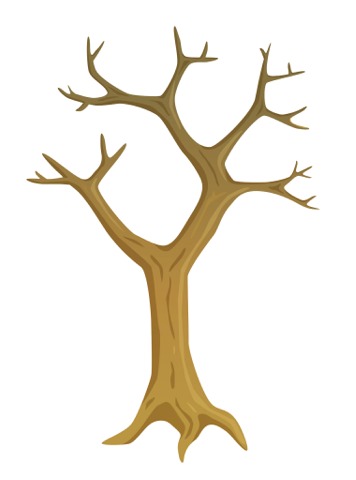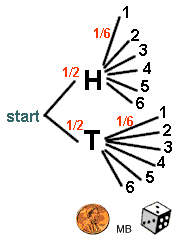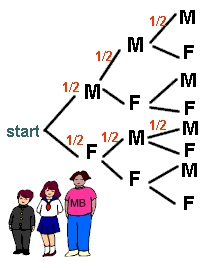|
When attempting to determine a sample space (all of the possible outcomes of an event), it is often helpful to draw a diagram which illustrates how to arrive at the outcomes.
One such diagram is a tree diagram. A tree diagram is a drawing with "line segments"
pointing out all of the possible "paths" for arriving at the outcomes.
Tree diagrams display all the possible outcomes of an event.
Each of the branches in a tree diagram represents a part of the paths to the possible outcomes.
By writing the probability of each branch directly on that branch, the probability of the outcome from that path can be quickly determined.
The probability of any outcome in the sample space is the product (multiplication) of all probabilities along a path that represents that outcome on the tree diagram.
Tree diagrams are very helpful when dealing with compound events. They clearly show how the events interact with one another as well as the total number of possible outcomes.
|
 |


Using a tree diagram, determine the sample space for tossing one penny and rolling one die.
(compound event) |
 Tree Diagram
Tree Diagram |
Start by tossing the penny. There will be two outcomes: heads, H, or tails T.
This will be the beginnings of two different paths in the tree diagram.
The probability of tossing H (or T) is 1/2 (as shown on the branches).
Now, from each outcome (H or T) in the path, roll one die.
There will be 6 possible outcomes from the roll, meaning 6 new paths from H and 6 new paths from T.
The probability of rolling 1, 2, 3, 4, 5 or 6 is 1/6. (as shown on the braches)
By following the different paths in the tree diagram, the sample space will be formed.
Sample Space:
{H1, H2, H3, H4, H5, H6,
T1, T2, T3, T4, T5, T6} |
The probability of each of these "path" outcomes is 1/2 • 1/6 = 1/12. |
|


There are three children in a family. How many outcomes can represent the order in which the children may have been born in relation to their gender. How many outcomes will be in the sample space indicating the gender of the children? Assume that the probability of male (M) and the probability of female (F) are each 1/2.
(compound event) |
 Tree Diagram
Tree Diagram |
The tree diagram is developed in the same manner as seen in Example 1.
Sample Space:
{MMM,
MMF,
MFM,
MFF,
FMM,
FMF,
FFM,
FFF}
|
There are 3 sections in the tree, each representing the birth and possible genders of children in the family, with the oldest child being listed first.
There are 8 final possible outcomes in the sample space showing the possible gender and age order for 3 siblings, with the oldest child listed first.
The probability of each of the outcomes is
1/2 • 1/2 • 1/2 = 1/8. |
|

NOTE: The re-posting of materials (in part or whole) from this site to the Internet
is copyright violation
and is not considered "fair use" for educators. Please read the "Terms of Use". |
|



